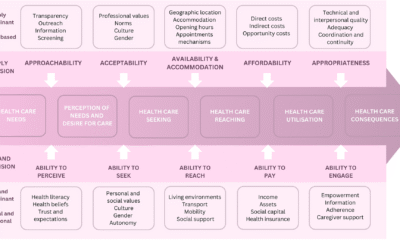Travel Journals
Should I stay or should I go? Why nurses are leaving community nursing in the UK | BMC Health Services Research

A well-functioning community care was listed as one of the nine pillars of a good health system by the European region World Health Organisation (WHO) … and best value for money’ (p.4–5), [1, 2]. Even prior to the COVID-19 pandemic, several European policy think tanks identified the importance of coordinated primary care reform policies and workforce policies. Their findings showed that nations in which the two policies misaligned were not as good at combating non-communicable diseases and other public health challenges [3]. The adjustment of the health services across Europe during the COVID-19 pandemic has demonstrated the pivotal role of primary care. An exploratory study by Wanat et al., during the pandemic in eight European countries found the responsiveness and proper resourcing of primary care to be critical during an infectious disease crisis [4]. Recommendations by the WHO that followed were to strengthen primary care services in their combat against the COVID-19 pandemic [5]. However, despite these recommendations most nations’ priorities have been focused on acute settings [6].
In the UK, the role of the community nurse is to carry out practice that is preventative, curative, and rehabilitative [7]. Community nurses are registered with the Nursing and Midwifery Council (NMC), educated to degree level, and provide care across a range of community settings (the home, care homes and clinics). District nurses are more senior. Also registered with the NMC and educated to degree level, they have obtained additional qualifications and tend to lead teams of other staff, playing a vital role in coordinating and orchestrating services and prescribing medication. District and community nurses make up a fraction of the overall UK nursing workforce, approximately. The Specialist district nursing qualification is obtained after a year-long university course. It includes academic course study and practical experiential learning within district nursing teams. It is estimated that between 30 and 50% of community nurses hold a specialist qualification.
Despite policy ambitions announced in 2009–2010, to offer more care close to home, a continued lack of resources, monitoring and oversight have shown a continued undervaluing and lack of appreciation for community services [8]. This has resulted in the number of qualified community nurses in the UK falling sharply by 42% between 2010 and 2018 [9]. This fall in numbers has not been reflected in other sectors of the UK nursing workforce in such dramatic fashion. The continuous underfunding of community care in the UK has created pressures that continue to compromise quality of care [10].
Further government policies, such as removal of nursing bursary, financial cuts, and workforce demoralisation, have seen this particular specialty brought to a state of crisis [11]. This negative development has peaked at a time when the demand on community nursing services has increased significantly, both in terms of the number of patients seen and the complexity of care provided. This pressure has become increasingly unmanageable in the period 2019–2021, during the COVID-19 pandemic, resulting in adverse effects on patient care [12].
The community nursing workforce pressures noted in a UK context are not exceptional. A recent review of the international literature, centred on nursing turnover in the community [13], indicates a range of factors impacting upon job satisfaction and intention to leave. These include remuneration, but also age and length of time in post, managerial style, and workload. The direct impact on the quality of care in community services is difficult to quantify. This is mainly due to a wide range of national indicators, which focus on organisation of care [14]. To date, the largest community nursing primary study in the UK carried out in early 2020 reported high levels of missed care in all categories of nursing care, severe understaffing, and a higher burden on those that are left in the profession (Senek et al., 2022). It is anticipated that high levels of burnout in community nursing is further worsening retention and recruitment of staff [15]. This evidence suggests that community services are stretched beyond breaking point, at a time when they are expected to bear a heavier load due to the pressure on hospital services in the third wave of COVID-19 pandemic. There is evidence that, along with other professionals and whilst remaining within existing scope of practice, community and district nurses have extended their roles and remit during the pandemic allowing general practitioners to see patients with more complex needs that would otherwise need to be looked after in the hospital setting [16]. As a result, the Department of Health estimates that demand for care will rise by a greater level than this staffing increase could match [17].
These worsening working conditions are believed to have a major impact on retention and recruitment of nursing staff. Previous review work on nurses’ intention to leave identified job-related determinants that had impact such as stress and job satisfaction, burnout, and job commitment. Job satisfaction which was shown to be strongly correlated with intention to leave among nursing staff [18] was a result of nurses’ inability to provide the best care that they wanted to (i.e. missed care) [19]. In fact, missed care was shown to be the largest determinant of nurses’ job dissatisfaction, followed by perceived lack of support, no action taken when concerns are raised, if they could not take a break, unpaid overtime and if the shift is understaffed [19] .
Whilst these individual indicators are important, these are situated within a complex set of relationships, involving the individual and the organisational context. A review of causal models, which included 24 papers assessing models of nursing turnover, identified burnout, job stress, organisational commitment, job satisfaction, organisational culture and empowerment as having directional relationships and with varying degrees of strength [20]. Similarly, a review by Daouk-Öyry et al., presented a conceptual (JOINT) model of turnover where three concepts of turnover – the interpersonal level (managerial style and relationships); the job level (job demands and job control) and the organisational level (human resources practices and structure), were moderated by individual level (demographics, personal characteristics, job attitude, health and well-being) and national level (labour supply and legislation) characteristics on turnover [21]. It then derived a model of interaction and interplay of the concepts that result in nurse turnover. This model was proposed to test hypothesized relationships and overall management practices [22] and provides an important backdrop to this study.
For a while, community nursing moved up the political agenda because of UK government policy commitments to move care closer to home, to address health inequalities and to prevent disease [23]. However, the system has not sufficiently recognised the vital strategic importance of community nursing services in realising a resilient health service. As a result, the health system faces significant challenges of rising demand at a time of constrained resourcing and capacity. This study aimed to examine the real-time working conditions and individual and organisational factors and their association with community nurses’ intention to leave across the UK.
Study design
We carried out a questionnaire of community nurses in the UK to explore differences in individual and organisational factors between those nurses that intend to leave and those that intend to stay in the community nursing profession. The data was collected by means of a cross-sectional survey via the largest closed, private community nursing online-forum. Logistic regression was carried out to ascertain the effects of the variables on the intention to leave. Data was collected between February 8th to April 26th, 2021. A web link to the questionnaire was posted on a closed and exclusive group forum by the group administrator. Qualtrics© web software was used to administer the questionnaire. Qualtrics© also operate on protected high-end firewall systems and uses encryptions for all transmitted data.
Survey development
The questionnaire had two components. One section focused on the prevalence and types of missed care and the other section focused on topics relating to working conditions. Both sections of the questionnaire were based on a validated questionnaire of community nurses working conditions by Phelan et al., [24]. This was followed by an iterative process of engagement with lead members of the UK Royal College of Nursing (RCN) to finalise the questionnaire. RCN participants included national professional nursing leaders in the fields of end-of-life care, education and district nursing and a district nursing academic. Iterations of the amended tool were circulated over a 6-week period and a consensus reached on relevance of the final items for inclusion and exclusion. The total number of questions in the questionnaire was 62. The questionnaire was piloted with 6 community nurses. The completion time was between 30 and 45 minutes.
Recruitment and consent
Participants were recruited via the largest national Community Nursing Forum in the UK with over 6000 members, hosted within a closed, private social media group. Eligibility criteria were; community nurse professions from any of the four countries of the UK (England, Wales, Northern Ireland or Scotland). Participants were required to indicate eligibility by confirming their registered status.
Participants
Community nurses of all Agenda for Change Band grades (NHS terms and conditions of service for non-medical staff) were eligible to take part. RNs with or without a Specialist District Nurse Practitioner Qualification (SPQDN) qualification were eligible to take part. The Specialist community nursing qualification is obtained after a year-long university course. It includes academic course study and practical experiential learning within community nursing teams. It is estimated that between 30 and 50% of community nurses hold a specialist qualification. We included all community nursing roles in our sample, if the participants themselves identified at community and/or district nurse. This could include any of the community nursing sub-specialities in the UK, for instance public health, occupational health.
For this study, we aimed to achieve a response rate of at least 10%. Out of the approximately 6000 forum members, 859 joined the study and started to complete the questionnaire. This is a response rate of 14%. However, out of these 859 responses, only 533 met the inclusion criteria (i.e., completion rate of 90% + of the questionnaire). Therefore, 326 responses were excluded in the final analysis. Therefore, our final response rate was just below the target at 8.8%.
Ethical approval
The study was approved by [Blinded for Peer review] ethics committee (REDACTED).
Confidentiality and safeguarding
All data collected during remained confidential and was only accessible to members of the research team. Data was stored on a secure server. All data was strictly anonymized for publication. No participants are identified in the publication.
Measured outcomes
We collected information that can be categorised into following domains: demographics, frequency, and type of missed care, staffing levels, reasons for missed care, job satisfaction and intention to leave.
Demographic variables
We collected non-identifiable participant data including role title, whether they hold an SPQDN qualification, age, gender, years in practice, Agenda for Change (Afc) pay grade (where band 5 is typical of those with least experience and/or level of education, bands 6, 7, and 8 are typical of those with higher levels of education/and or experience), part-time/full time working, country of the UK, and first four digits of their work postcode.
Missed care and types of missed care
‘Due to a lack of time did you leave necessary care (any aspect of required patient care) undone on your last shift? The response options were ‘yes’ or ‘no’.
Working conditions
Participants listed their current caseload (current active caseload measured as the total number of patients that are assigned to them individually), additional caseload attributable to staff absence on their last shift (additional caseload measured as additional number of patients allocated to them on that shift due to staff absence) and the proportion of their caseload that are COVID-19 related cases (additional COVID caseload measured as number of patients that are have COVID or COVID-related complications), caseload increase due to COVID (Has your caseload increased due to COVID-19 pandemic). We also asked how many patients they had seen on their last shift (measured as total Number of Patients seen). They were also asked about the number of RN vacancies in the team (Proportion of Permanent Staff variable), Total hours worked on the last shift (length of shift measured as hours and minutes), travel mileage on the last shift (travel mileage), manager support (measured as dichotomous reply Yes (supported) No (unsupported), have working conditions worsened in the last year (measured as Yes/No dichotomous reply), and time spent per patient (measured in minutes).
Travel Journals
Road trip toys for 2 year olds cheap – emsnow.com
Travel Journals
Heads Up: New Ottawa airport bus, Munster farm dinner, river swimming, Quebec spas

484
This week’s Heads Up has the scoop on rental sports gear in the Outaouais, a farm-to-table dinner in Munster, a new bus to the Ottawa airport, a new restaurant in Kemptville, a bike ride near Eganville, açaí treats at St. Laurent Shopping Centre, day tripping to New Edinburgh and Rockcliffe, and more. Enjoy!
Cheese shop getting close to 100 percent Canadian stock
As you already know, I’m a big fan of supporting Canadian products—just check out my big guide to shopping locally. So a recent Facebook post by the Balderson Village Cheese Store, just outside Perth, caught my eye. The store’s owners have been making a concerted effort to stock 100 percent made-in-Canada foods. They’re about 75 percent of the way there and hope to have 100 percent Canadian stock by the end of the year. Well done!
You can rent scooters, pontoon boats and more in the Outaouais
Want to explore the great outdoors in the Outaouais, but you don’t have the gear? Tourisme Outaouais has this handy list of companies that rent out kayaks, paddleboards, canoes, electric bikes, scooters, pontoon boats and more.
OC Transpo to launch new bus to the airport
Perhaps finally realizing that folks travelling from Ottawa’s east end to Ottawa International Airport don’t much fancy taking three trains to reach their destination, OC Transpo is launching a direct bus service connecting the St. Laurent, Train and Hurdman stations to the airport. According to this CTV Ottawa story, Route 105 will launch on Sunday, August 24, and will run every half hour, 24 hours a day, seven days a week. The bus is anticipated to take 33 minutes to travel from St. Laurent to the airport.
Quebec loves its Nordic spas
Quebec seems to have embraced the Nordic spa concept—the circuit of hot tub or sauna, cold pool or shower, relaxation and repeat—more strongly than just about anywhere else in Canada. I’ve written a post about some of my favourite Quebec Nordic spas, and it barely scratches the surface. My friend Hilary Nangle recently wrote a post about her favourite Quebec Nordic spas and while there’s a bit of overlap between the two pieces, she’s discovered quite a few spots that I haven’t made it to … yet.
Science fiction, fantasy and horror book convention is coming to Kanata
I wanted to mention this event on the website last year, but by the time I heard about it, it had sold out! So if you’re a fan of Canadian science fiction, fantasy and horror novels, you might want to get your ticket to Can*Con now. You can meet authors, buy books, take classes, pitch your own book to agents and more. It’s happening at the Brookstreet Hotel in Kanata from October 17 to 19.
New restaurant opens in Kemptville
Named for a famous local Holstein bull, Goldwyn’s restaurant opened this past weekend at 25 Clothier Street East in downtown Kemptville. It promises diners “a modern take on the Wild West at our elevated country western saloon.” Sounds like fun!
You can take a staycation in New Edinburgh and Rockcliffe
Fancy staying close to home? I have just the suggestion: a day spent exploring New Edinburgh, Lindenlea and Rockcliffe. From the new(ish) NCC River House on the Ottawa River to a posh grocery store and a great place to pick up consignment designer clothes, you can read my day trip tips in the Ottawa Business Journal.
Saunders Farm Pig and Corn Roast tickets are available
Most years, the farm-to-table Pig and Corn Roast at Saunders Farm in Munster sells out. So if you want to go to this year’s event on Sunday, August 24, you might want to get your tickets now.
Scenic August bike ride will take cyclists along Eganville backroads
If you want to challenge yourself to a self-supported, non-racing bike ride through the hills and along the backroads near Eganville, now’s the time to register for this year’s Tour de Bonnechere on Sunday, August 24. You can choose from 50km, 65km and 100km routes, as well as a 20km family ride.
You can try a superfood at St. Laurent Shopping Centre
Perhaps açaí berries are old hat to you. I’d heard of them but hadn’t had a chance to taste the Brazilian “superfood” until I was invited to try it at Rio Açaí at St. Laurent Shopping Centre. (The owners also have a location at 35 allée de Hambourg in Gatineau.)
Açaí berries have become trendy in recent years for their health benefits. At Rio Açaí, you can try them in a bowl with your choice of other fruits (I picked mangoes, strawberries and blueberries). The consistency of puréed açaí is a bit like tapioca pudding and it isn’t super sweet, so it made a nice combo with the sweet, dense fruit. You can also try other Brazilian specialties at the takeout spot, such as warm cheese bread (it’s really good) and, of course, coffee.
(Disclosure: I received free products for review purposes. The shop did not review or approve this post. All opinions are my own.)
Looking for more tips on things to see and do in and around Ottawa? Subscribe to my free weekly newsletter or order a copy of my book, Ottawa Road Trips: Your 100-km Getaway Guide.
As the owner of Ottawa Road Trips, I acknowledge that I live on, work in and travel through the unceded, unsurrendered territory of the Algonquin Anishinaabeg Nation. I am grateful to have the opportunity to be present on this land. Ottawa Road Trips supports Water First, a non-profit organization that helps address water challenges in Indigenous communities in Canada through education, training and meaningful collaboration.
Travel Journals
Seven highlights of the former capital

Walk five minutes south of the monastery, past one former synagogue – Santa Maria La Blanca, reputed to be Europe’s oldest – and you arrive at another. The magnificent carved wooden ceilings and plasterwork walls of El Transito blend Mozarabic decorative influences. Constructed in 1355, El Transito houses the Sephardic Museum, which accounts for Toledo’s long Jewish history. You’ll find good information sheets in English and the museum has some especially beautiful ceramics. Pause afterwards in the synagogue’s small memorial garden. See spain.info
Take in the art at Hospital de Tavera
Patio in Hospital de Tavera museum.Credit: Alamy
Don’t like monuments and art? Better skip Toledo, which has them in spades. This Renaissance palace, built by a cardinal for the needy, is a whopper. The architectural highlight is the symmetrical double courtyards, while a wealth of paintings includes masterpieces by El Greco, Tintoretto and Zurbaran. Cardinal Tavera’s marble tomb is a sculptural work of art too, with no sign of humility other than a little memento mori skull tucked under his pillow. See fundacionmedinaceli.org
Admire El Greco paintings
Museum El Greco.Credit: iStock
Toledo is associated with El Greco, the 16th-century painter whose works seem astonishingly modern. You can see quite a few of his paintings in Toledo, and all are odd and electrifying. The church of Santo Domingo Monastery where the painter is buried has top examples including the altarpiece Assumption of the Virgin showing Mary springing from her tomb like a jack-in-the-box. El Greco Museum (in a house where El Greco never lived, despite claims) has several superb later works. See museodelgreco.sacatuentrada.es
Fill up at Confiteria Santo Tome
Santo Tome shop in Zocodover Square, Toledo.Credit: Alamy Stock Photo
If El Greco’s elongated, hollow-cheeked saints make you peckish, take a break from gloomy painted art and indulge in happy edible art instead. Toledo nuns are said to have invented marzipan – which is disputed – but Toledo has certainly produced it for centuries. Santo Tome, in business since 1856, is Spain’s best-known marzipan maker. You can devour biscuits, pastries, cakes, sweets and marzipan fruit filled with lip-licking goo. Like El Greco’s saints, you’ll soon be in heaven. See mazapan.com
Take a hike to Mirador del Valle
There are sweeping views of Toledo and the Tagus River from Mirador del Valle.Credit: iStock
Loading
In this old town of closed-in alleys, you’ll want to get beyond the walls to admire Toledo’s fabulous setting above the Tagus River, dominated by the whopping Alcazar, or fortress. This viewpoint is a 40-minute walk from Puente Nuevo bridge just below the fortress, but outlooks are fabulous all the way. Sunset and twilight are the most atmospheric. The lazy option is a taxi to nearby Parador de Toledo for a cocktail on the terrace. See paradores.es
The writer travelled at his own expense.
-

 Brand Stories2 weeks ago
Brand Stories2 weeks agoBloom Hotels: A Modern Vision of Hospitality Redefining Travel
-

 Brand Stories1 week ago
Brand Stories1 week agoCheQin.ai sets a new standard for hotel booking with its AI capabilities: empowering travellers to bargain, choose the best, and book with clarity.
-

 Destinations & Things To Do2 weeks ago
Destinations & Things To Do2 weeks agoUntouched Destinations: Stunning Hidden Gems You Must Visit
-

 Destinations & Things To Do1 week ago
Destinations & Things To Do1 week agoThis Hidden Beach in India Glows at Night-But Only in One Secret Season
-

 AI in Travel2 weeks ago
AI in Travel2 weeks agoAI Travel Revolution: Must-Have Guide to the Best Experience
-

 Brand Stories1 month ago
Brand Stories1 month agoVoice AI Startup ElevenLabs Plans to Add Hubs Around the World
-

 Brand Stories3 weeks ago
Brand Stories3 weeks agoHow Elon Musk’s rogue Grok chatbot became a cautionary AI tale
-

 Asia Travel Pulse1 month ago
Asia Travel Pulse1 month agoLooking For Adventure In Asia? Here Are 7 Epic Destinations You Need To Experience At Least Once – Zee News
-

 AI in Travel1 month ago
AI in Travel1 month ago‘Will AI take my job?’ A trip to a Beijing fortune-telling bar to see what lies ahead | China
-

 Brand Stories2 weeks ago
Brand Stories2 weeks agoContactless Hospitality: Why Remote Management Technology Is Key to Seamless Guest Experiences













